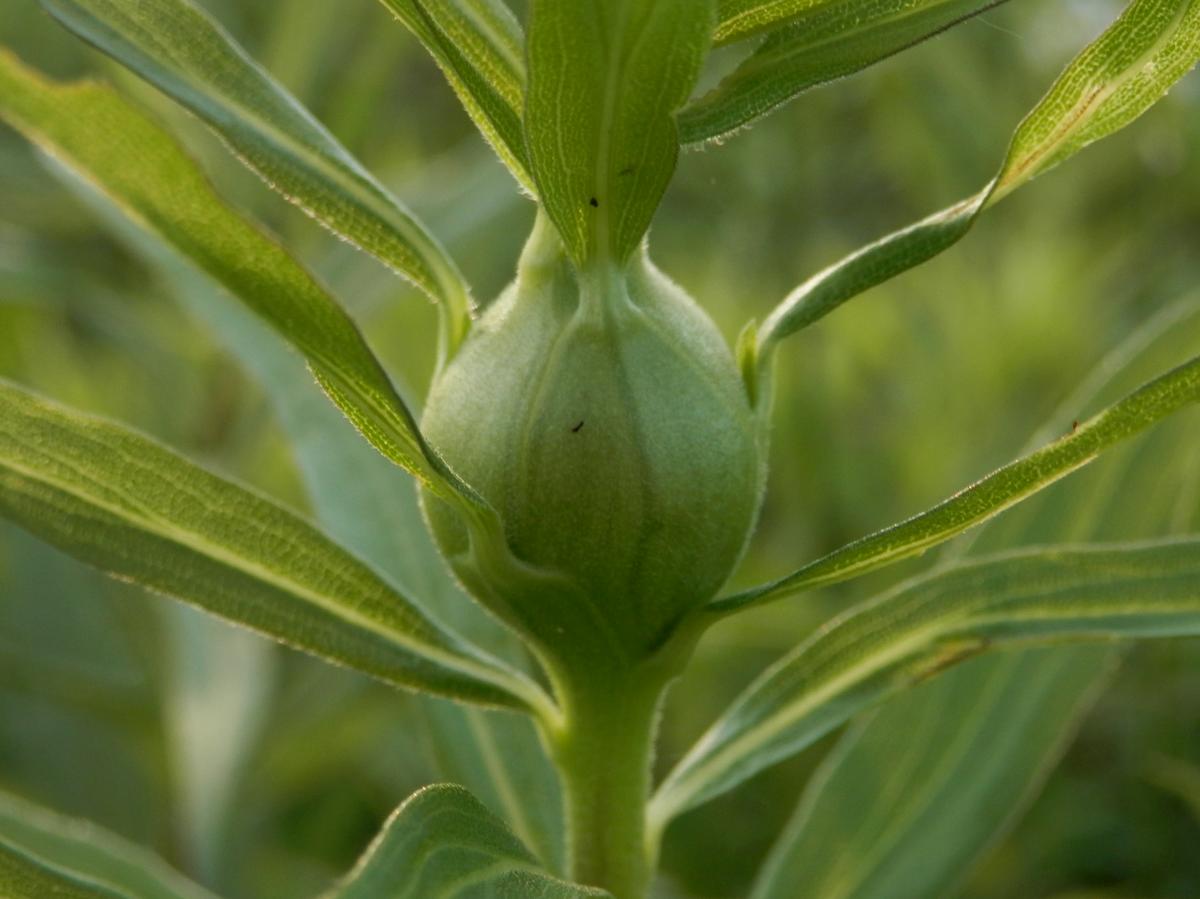Wherever there’s sunshine in our region – open fields, woodland edges, roadsides, or even untended urban lots – you are likely to find goldenrod, especially of the genus Solidago. If you’ve looked closely, you may have wondered about the round growths on many goldenrod stems. What are they? Why are they there? Is the plant sick? What’s inside?
The round stem-balls are called galls. They are the plant’s response to the parasitic goldenrod gall fly, Eurosta solidaginis. The female fly lays eggs at the base of goldenrod flower buds. Upon hatching, larvae eat into the stem, whereupon they secrete chemical compounds that trigger the plant’s meristem cells to form the gall. The gall grows around the larva, forming a hard outer layer and a softer fibrous interior. The larva eats the inner tissue and grows, but the plant is not harmed. The fly will have no other food throughout its whole life cycle, as adults lack mouthparts and do not eat at all.
In late fall, the larva chews a tunnel right up to the outer margin of the gall, but not all the way through. Then the larva enters diapause, waiting out the winter. The gall provides negligible thermal insulation, but the larva can still survive temperatures as low as -40 degrees Celsius. It freezes solid, but produces enough cryoprotective chemicals (glycerol, sorbitol, and trehalose) that vital components remain liquid within cells.
Then as the weather warms in spring, the larva pupates. The adult emerges in May or early June via the tunnel that it excavated the previous fall, pushing through the thin epidermal cap left at the opening. The fly now has only about two weeks to live, barely enough time to find a mate and start the life cycle anew. Capable only of weak flight, the fly never strays far from the goldenrod patch where it began life as an egg the previous year.
Researchers led by Warren Abrahamson at Bucknell University have determined that various races of Eurosta solidaginis show distinct preferences for particular goldenrod host species (Solidago canadensis, S. altissima, and S. gigantea). The female fly seeks out the preferred goldenrod species using chemical receptors on her feet, antennae, and even ovipositor. This choosiness means that within a single field or even in neighboring clusters of goldenrod plants, Eurosta solidaginis races may be reproductively isolated from each other. Such isolation raises the intriguing possibility that these races are already progressing toward speciation, right next to each other and practically right before our eyes.
As cozy and nourishing as it might seem for a larva, a gall does have its vulnerabilities. During summer, a parasitoid wasp called Eurytoma gigantea seeks out galls. The female wasp inserts her ovipositor through the gall’s outer wall, laying an egg in the chamber that already holds the gall fly’s larva. Upon hatching, the wasp larva devours the fly larva, then consumes gall tissue until it pupates. Then a different threat to gall flies arises in fall and winter, as Downy Woodpeckers and Black-capped Chickadees peck open the galls to get at the fattened larvae inside.
In studying the relationships among flies, wasps, birds, and goldenrod, Abrahamson and colleagues have discovered still more fascinating dynamics. Where Eurytoma wasps are common, the fly larvae survive much better in large galls, whose walls are more difficult for the wasp’s ovipositor to penetrate. Conversely, Downy Woodpeckers favor large galls, perhaps because they are more likely to contain a fly larva than a wasp larva, which is smaller and less nutritionally rewarding. The relative abundance of the wasps and woodpeckers may therefore define the direction of selection pressure for what sizes of galls are best for flies. More wasps mean that flies are more successful if they induce large galls. More woodpeckers means that flies do better if they induce small galls. Both wasps and woodpeckers together may create a stabilizing effect, in which natural selection most favors the flies that induce intermediate-sized galls.
Thus, the odd little balls that we see on goldenrod tell us about much more than just a single connection between an insect and a plant. They reveal a complex web of relationships among goldenrod, flies, wasps, and birds, bridging three trophic levels and spanning various levels of space and time. With patient scientific inquiry, our simple initial questions have led to wider answers, and eventually to profound interdisciplinary insights into anatomy, physiology, behavior, ecology, and indeed evolution itself.


